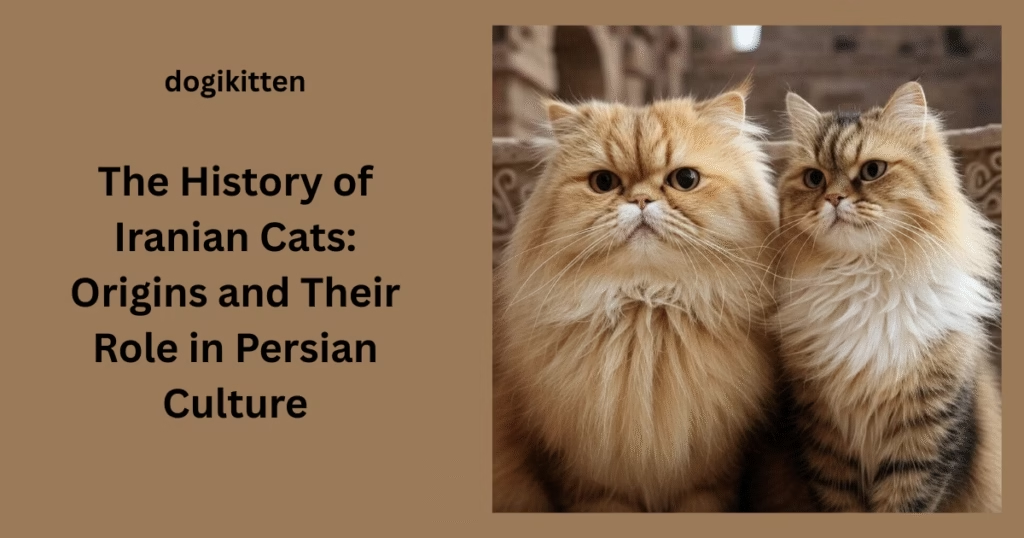
A comprehensive exploration of Iranian cats—their ancient origins, lineage of Persian and traditional breeds, symbolic significance in literature, art and folklore, and the modern beloved Persian kitten.
- Introduction: Why “Iranian Cats” Matters
- Ancient Origins and Early Domestication
- Arrival in Europe & Breed Development
- Royalty, Literature & Persian Art
- Mythology, Folklore & Spiritual Beliefs
- Modern Iranian Cats: Persian & Traditional Breeds
- Care, Grooming & Persians as Pets
- The Enchanting Persian Kitten
- Conclusion
- FAQs
Introduction: Why “Iranian Cats” Matters
“Iranian Cats” refers to the long-haired felines historically bred in Persia (modern-day Iran) that eventually became known worldwide as Persian cats. But the legacy stretches beyond just one breed—it encompasses cultural significance, royal companionship, folklore symbolism, and modern pet adoration.
1. Historical Depth & Roots in Ancient Persia
“Iranian Cats” aren’t just a modern pet – they’re deeply rooted in the ancient lands of Persia, particularly regions like Khorasan, Isfahan, and Shiraz. Longhaired felines have been cherished in these areas for centuries, with historical records and travelers’ journals from the Safavid era (1500s–1600s) noting their elegant presence in royal households . The term “Persian cat” itself reflects this heritage, as early exports of these cats to Europe came directly from Persia (modern-day Iran) .
2. Cultural and Spiritual Symbolism
In Persian culture, cats have long symbolized grace, elegance, and divine protection. Ancient Persian art, poetry, and architecture frequently feature cats, associating them with nobility and mysticism . Persian poets—like Hafez—used descriptions of cats’ “sapphire eyes” and “silken fur” to evoke refined beauty and inner contemplation catbeep.com. Folklore credits cats with guarding against evil spirits and bringing good fortune to households, elevating them from mere pets to esteemed protectors and companions .
3. Royal Patronage & Aristocratic Allure
Iranian cats gained royal patronage centuries ago. Qajar shahs—like Nāṣer al-Dīn Shah—and other elite Persians favored these cats, even employing attendants to care for them within palace settings. Their reputation for elegance and calm demeanour made them a symbol of aristocratic taste and refinement, which eventually attracted the attention of European royalty, including Queen Victoria.
4. Global Influence & Breed Identity
The legacy of Iranian cats expanded beyond Persia when they were brought to Europe by travelers such as Pietro della Valle and Nicolas-Claud Fabri de Peiresc in the early 1600s . Official breed introductions at the London cat show in 1871 and subsequent breeding efforts solidified “Persian” as a distinct and popular breed—so rooted in culture that the name “Persian cat” remains synonymous with the long-haired elegance that originally came from Iran .
5. Cultural Continuity into Today
Even now, “Iranian Cats” symbolise a link between heritage and modern pet culture. In Iran, cats remain common companions—valued both for their independence and their cultural resonance . Globally, the Persian breed is cherished for its calm temperament, luxurious coat, and quiet disposition .
Why All This Matters
| Reason | Explanation |
|---|---|
| 🐾 Cultural Identity | Understanding Iranian cats provides insight into Persia’s cultural history, where animals were revered in art, literature, and royal courts. |
| 🐱 Breed Evolution | Tracing how these cats traveled from Persia to Europe helps us understand how Persians became one of the world’s most beloved cat breeds. |
| ❤️ Modern Connection | Persian cats today carry centuries of symbolism and heritage, resonating with owners who appreciate both their beauty and storied past. |
By viewing Iranian cats through this lens, we recognize them not only as pets but as living embodiments of Persian elegance, refinement, and cultural legacy—making them a subject worthy of deeper exploration.
Ancient Origins and Early Domestication
The story of Iranian cats begins thousands of years ago in the heartlands of ancient Persia—modern-day Iran—and surrounding regions.
Origins in Persia and Beyond
Long-haired cats are believed to have first appeared in areas like Khorasan (eastern Iran) and parts of present-day Afghanistan, southeastern Turkey, and Uzbekistan . While the precise origin is debated, 16th–17th century travelers documented these elegant cats in Persian cities such as Isfahan, where royalty and nobility kept them as cherished companions .
Genetics reveals a complex story: although these cats arrived via Persia, modern Persians are now genetically closer to European breeds—suggesting heavy European breeding over time .
Evidence of Early Domestication
Fossil records indicate that domestication of cats began around the Fertile Crescent, potentially 9,500 years ago . By the time cats with long fur appeared in Persia, the region had a well-established tradition of cat keeping—especially within palace life. European travelers in the 17th century observed long-haired “Persians” in royal Persian courts .
Historical Mentions in Persia
Persian documents from the Sassanid and early Islamic periods suggest cats were traded and owned widely—sometimes dyed, adorned, or used in sympathetic magic traditions . Notably, the Deylamite ruler Rokn-al-Dawla (10th century) was known for pampering his cat, even having pet attendants iranicaonline.org.
This long-standing affection shows cats had social and symbolic importance far earlier than often assumed.
Mythology, Folklore & Spiritual Beliefs
In Persian myth and folk tradition, cats were more than pets—they were woven into religious symbolism and household practices.
Zoroastrian & Sassanid Myths
Some late Sassanid and Middle Persian sources reflect ambivalent views: certain texts associate cats with malign beings or demons, possibly influenced by older beliefs . For example, in Pahlavi texts, cats are described as descendants of wolf-like demons or evil spirit creations .
Yet, alongside these darker narratives, cats also carried blessings. A folk belief held that consuming black-cat meat would confer courage or protection—especially among groups like the Isma’ilis .
Cultural Practices & Symbolism
Cats in Persia were sometimes draped with jewelry, dyed, and allowed to sleep in harem quarters, speaking to their elevated social status. Women doted on kittens, even equipping them with earrings and small necklaces.
They were also viewed as spiritual sentinels—believed to ward off evil spirits and bring good fortune into households .
Folklore & Legends
Persian folklore abounds with cat-centric tales—warrior cats overcoming rats and mystical origin myths linking cats with gods or magical cargo moving through ancient trade routes . While not as prominent as other mythical creatures, these tales kept the cat’s cultural image alive.
Why It Matters
Understanding these roots helps explain why Persian cats are still seen today as not just pets but historic and cultural emissaries.
These myths and practices underscore cats’ deep emotional, spiritual, and symbolic roles in Persian life, extending far beyond practical rodent control.
The royal treatment of cats—from adornment to guardianship—reveals the early reverence that foreshadowed the breed’s later global prestige.
Arrival in Europe & Breed Development
Early European Introductions
Long-haired “Persian” cats first captivated Europe in the early 1600s. Italian traveler Pietro della Valle brought grey-coated cats from Khorasan (now eastern Iran/Afghanistan) to Italy around 1620, while Nicolas‑Claude Fabri de Peiresc imported white-coated longhairs from Damascus to France at roughly the same time . These early imports introduced Europeans to the luxurious, silky-furred felines that would later be formally recognized as “Persian” cats.
17th–18th Century Cultural Fascination
During the late 17th to 18th centuries, these exotic cats spread among European nobility. They were cross-bred with local breeds such as Angoras to reinforce their long coat and create new color variations . By the Victorian era, owning a Persian cat became an aristocratic status symbol—fine-coated felines lounging in salons and royal courts across Britain and France .
The Birth of the Cat Fancy
The modern “cat fancy” began in England, centered around Harrison Weir—dubbed the “Father of the Cat Fancy.” He organized the first official cat show in July 1871 at Crystal Palace, London, under the guidance of his breed standards . That event showcased many varieties of long-haired cats, including Persians, Angoras, Russian Longhairs, and more .
A Persian won Best in Show—cementing the breed’s popularity—and Queen Victoria herself purchased blue Persians, giving the breed enormous prestige .
Breed Standardization & Divergence
Following the 1871 show, breed standards were published in 1889—starting with Weir’s “points of excellence”—helping differentiate Persians from Angoras. Traits like a round head, shorter muzzle, less pointed ears, and a fuller, coarser coat became key features .
In 1903, Frances Simpson’s The Book of the Cat offered further classification and heralded blue Persians as a classic lavender-blue staple—boosting breed recognition in both England and America .
An Evolving Breed
By the early 20th century, American breeders imported Persians, developing two distinct “types”:
- Traditional (“doll-face”) Persians with longer muzzles.
- Modern (“flat-faced” or “peke-faced”) Persians, shaped by a mid‑20th century mutation later bred for show purposes .
Despite health concerns (like respiratory issues and tear-duct problems), the flat-faced phenotype became highly sought-after in show circuits via selective breeding .
A Global Breed
The Persian’s journey to North America began in the late 19th century, soon becoming a defining breed of the nascent Cat Fanciers’ Association (founded 1906). During the Industrial Revolution and beyond, global trade and increased wealth boosted the breed’s popularity among the affluent .
Voices from the Community
On r/iran, one user emphasized:
“The breeding that provided today’s Persian cats and the standards set… came from Europe and not Iran.”
Another noted:
“The origin and provenance… is rather murky… We do know about its introduction to Europe around the 1600’s and their first official recognition at the 1871 cat show in England.”
Why This Matters
Selective breeding during the 20th century solidified the diverse “traditional” and “flat-faced” Persian types, shaping the silhouettes we know today.
These early imports and crossbreeding defined the underpinnings of what became the modern Persian.
The 1871 Crystal Palace show marked the transformation from exotic curiosity into a codified, show-driven breed.
Royalty, Literature & Persian Art
🏰 Royal Companionship and Aristocratic Prestige
Iranian cats were more than pets—they were part of the royal aesthetic. During the Qajar era (1789–1925), Persian royal courts often featured cats in their portraiture, lacquerware, and decorated manuscripts, portraying feline companions alongside monarchs and nobles . Persian folklore and animal symbolism celebrate cats as guardians of wealth, bringers of good luck, and protectors of the home—beliefs reinforced by their consistent depiction in elite settings .
🖋 Persian Poetry and Literary Symbolism
Cats wove themselves into classical Persian poetry, praised for their grace, mystery, and contemplative presence . Iconic poets like Hafez, Saadi, and Rumi employed feline imagery: “sapphire eyes,” silken fur, feline serenity—as metaphors for spiritual beauty and introspection . In mystical works such as The Conference of the Birds by Attar of Nishapur, cats symbolize spiritual wisdom guiding seekers on inner journeys .
🎨 Persian Miniature Paintings & Manuscripts
While domestic cats are rarer in medieval manuscripts than lions or cheetahs, they do appear—particularly in manuscript illuminations of Qajar bindings showing domestic scenes with women and pet cats . One vivid example is a scene from a 1648 Shahnama manuscript, revealing a kitten riding a horse—a playful testament to their presence in royal culture . Persian miniatures balance realism with whimsy, using cats as elegant details to represent domesticity and refinement .
🖼 Influence Beyond Borders: Orientalism & Renaissance
In Europe, during the Renaissance and later Orientalist art waves, Persian cats symbolized opulence, exotic beauty, and mystique . Artists painted them alongside nobles or in imaginary “Eastern” settings, leveraging their distinctive form to evoke Persian luxury for Western audiences . This helped cement Persian cats as cultural ambassadors of elegance and refinement.
Why This Matters
Cultural Bridge: Their imagery in Orientalist art helped shape global perceptions of Persian elegance, making cats visual shorthand for aristocratic beauty in the West.
Symbols of Status: Their frequent appearance in royal art and literature reflects not just pet-keeping but also deliberate cultural symbolism—refinement, protection, and stature.
Literary Beauty: Inclusion in classical and mystical poetry underlines their role as metaphors for contemplation, elegance, and spiritual depth.
Mythology, Folklore & Spiritual Beliefs
🐾 Syncretic Symbolism in Persian Myth and Folklore
Cats in ancient Persia were multifaceted symbols—feared by some, revered by others, and often central to spiritual belief systems. One intriguing practice described in Middle Persian texts is the consumption of black-cat meat, believed to endow the eater with courage and protection from magic—especially among Isma’ili assassins. Simultaneously, folk prohibitions existed against killing or trading cats, suggesting they were also held sacred and respected .
These conflicting views—part reverence, part superstition—highlight the powerful mystical associations Persians attributed to cats.
👑 Royal Ties & Devotional Care
By the 10th century, Persian rulers such as Prince Rokn-al-Dawla were known not only to own cats, but to lavish them with luxury and ritual attention. Kittens were expensive, adorned with jewels, and even slept in the royal harem—further evidence of elite devotion .
This royal companionship reinforced the belief that cats acted as spiritual guardians, protectors of human spaces, and companions to the elite.
🏡 Domestic Guardians & Bring‑ers of Luck
Even beyond royal circles, cats were believed to ward off evil spirits and bring good fortune to ordinary households. This belief—found in both art and folk tradition—fostered a cultural reverence for feline presence in the home .
Such beliefs persist today: cats remain welcome in many Iranian households, where they are seen as both companions and protectors .
🌌 Mythic Origins: The Mystical Persian Cat
Among the most enchanting legends is the creation myth: Persian hero Rostam is said to have been gifted a magical kitten from a magician who crafted it from smoke and stars—endowing the cat with celestial mystery.
Additionally, tales like that of “Mitra”—a cosmic feline sent to bless villages—remain popular, weaving histories of mystical roots into everyday Iranian storytelling .
Why It Matters
Cultural Continuity: These traditions persist today, informing how Iranians relate to cats—as symbols of luck, grace, and mystic guardianship.
Spiritual Duality: Persian culture balanced superstition and sacred awe when it came to cats—sometimes feared for magic, other times revered for protection.
Elite and Popular Veneration: Both rulers and commoners respected cats, evidenced by devotional care and widespread folklore.
Modern Iranian Cats: Persian & Traditional Breeds
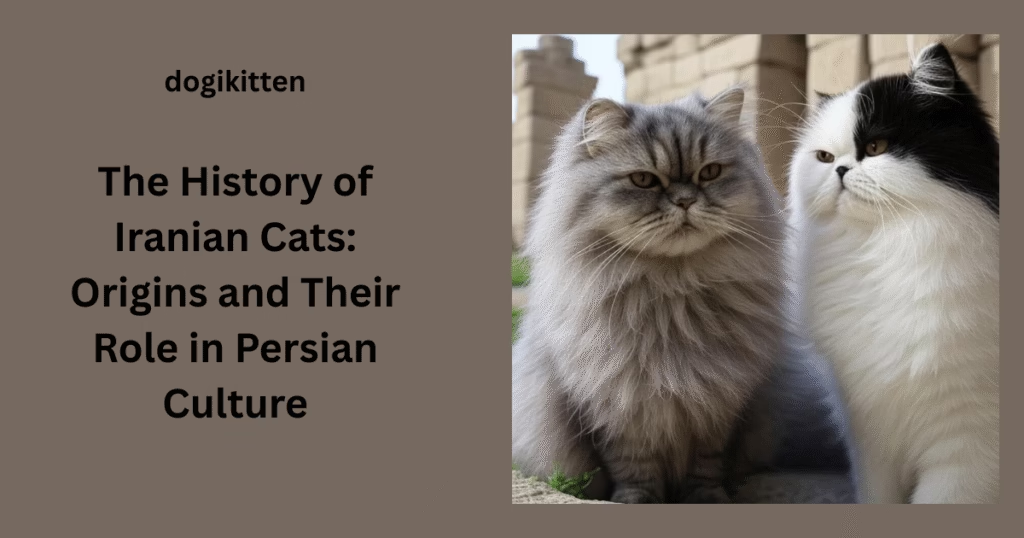
🌿 Traditional (Doll‑Face) Persians – Preserving the Heritage
- Origins & Description: Also called Traditional, Doll‑Face, Classic, or Original Persians, these cats retain the facial structure and build of the breed’s 19th-century Persian ancestors—moderate muzzle, round head, and large expressive eyes .
- Physical Traits: They have a sturdy, muscular frame, dense double coat, pronounced muzzle, and full facial ruff—far more natural-looking than modern show types .
- Temperament & Lifespan: Calm, affectionate, and less prone to face-related health problems, their average lifespan is 12–13 years .
- Cultural Presence: Many Traditional Persians featured in film and media, such as eight James Bond movies until 1963, highlighting their already iconic status .
- Popularity: They remain popular among enthusiasts who prioritize health and classic looks over extreme show standards .
✨ Modern (Peke‑Face / Ultra‑Type) Persians – The Show Ring Icons
- Origin: A brachycephalic (flat‑face) mutation first appeared in red tabby Persians in the late 1950s USA, later bred selectively for show appeal .
- Appearance: “Peke-face” Persians have ultra-flat faces, round eyes close to the skull, and compact bodies—strictly following show standards that favor dramatic aesthetics .
- Health Concerns: This breeding direction increased incidence of breathing difficulties, chronic eye tearing (epiphora), dental misalignments, and skin-fold infections .
- Genetic Shift: Genetic testing shows modern Persians are more related to European short-haired breeds—British Shorthair, American Shorthair—than to their Iranian forebears .
⚖️ Traditional vs Modern – a Side-by-Side Comparison
| Feature | Traditional (Doll‑Face) | Modern (Peke‑Face) |
|---|---|---|
| Facial Structure | Defined muzzle; moderate flatness | Ultra-flat face; pushed-in nose |
| Health Issues | Fewer respiratory or ocular problems | High risk of BOAS, epiphora, dental malformations |
| Coat & Grooming | Long, silky double coat; daily grooming | Equally luxurious coat; extra care due to eye secretions |
| Temperament | Affectionate, calm, loyal | Similar personality traits though possibly more show-driven by breeding practices |
| Popularity | Favored by health-conscious owners | Dominates show circuits; prized for extreme looks |
🌱 Other Variants Derived from Iranian Cats
- Exotic Shorthair: Created by crossing Modern Persians with American Shorthairs; they share the same body type but sport a low-maintenance coat and the flat-show face .
- Himalayan & Chinchilla: Himalayan cats blend Persian body with Siamese points; Chinchilla Persians emphasize silver coloring, yet both maintain Persian temperament and facial features .
🧭 Why This Section Matters
- Health vs Aesthetics: Understanding the differences helps potential owners make informed choices—balancing charm with health.
- Cultural Link: Traditional Persians maintain a stronger genetic and aesthetic link to original Iranian cats.
- Breed Awareness: Highlighting these distinctions supports responsible breeding practices and breed welfare.
👶 Focusing on the Persian Kitten
Persian kittens—whether traditional or modern—share traits like plush coats, round eyes, gentle temperaments, and a preference for indoor, calm environments . Traditional (doll-face) kittens are especially ideal for first-time owners due to reduced health issues and natural features. Early grooming and socialization are key to their well-being.
Care, Grooming & Persians as Pets
🛁 Grooming: A Daily Commitment
Persian cats have lush, long coats that require daily grooming to prevent mats and tangles—especially around the belly, legs, ears, and tail folds . Use a slicker brush and wide-tooth metal comb to reach deep into the undercoat, removing loose hairs before they form knots .
Sample daily routine:
- Comb through coat from head to tail, focusing on problem areas
- Brush gently with slicker to smooth and remove loose hair
- Always stay calm and reward your cat for good behavior
🧴 Bathing: Every Few Weeks
Persians need bathing every 4–6 weeks to keep the coat clean and shiny . Use lukewarm water and cat-safe shampoo, and follow with a thorough dry and brush session to prevent new tangles .
👁️🗨️ Eye & Face Care
Their flat faces make Persians prone to tear staining and crust buildup. Gently wipe around the eyes daily with a damp cotton pad to prevent blockages and staining .
🐾 Nails & Ears
Trim nails every 2–3 weeks to prevent overgrowth . Check ears weekly, gently cleaning wax or debris with cat-safe solutions—never insert cotton swabs into the ear canal .
🧠 Toys & Exercise
Though not highly active, Persians benefit from light play such as feather wands and scratching posts to reduce obesity and hairballs .
🍽️ Nutrition & Weight
Feed measured meals twice daily—avoid free-feeding—to maintain healthy weight and prevent KBr causing digestive issues . Provide high-protein diets and access to fresh water; wet food is particularly beneficial for hydration .
🏥 Health Checks
Persians are predisposed to respiratory, eye, dental, and kidney issues. Schedule yearly vet check-ups and consider genetic screening when selecting breeders .
❤️ Creating a Comfortable Home
Persians thrive indoors in calm environments. Provide soft bedding, clean litter boxes, elevated perches, and climate control—especially in warm weather—to prevent overheating due to dense fur .
Community Wisdom: Reddit Tips
Persian-cat owners recommend using multiple specialized brushes (comb, slicker, detangler) and establishing 5-minute daily grooming sessions for easier care . Clean the face gently, and only bathe as needed—over-bathing may dry out the skin .
Why It Matters
- Health: Prevents painful mats, eye infections, and obesity
- Bonding: Grooming is a shared time that strengthens the pet-owner relationship
- Well-being: Regular routine and proper environment keep Persians happy and thriving
The Enchanting Persian Kitten
🌟 Appearance & Early Traits
Persian kittens immediately win hearts with their plush, long coats, large rounded eyes, and signature flat faces. Most weigh between 7–12 lb (3.2–5.4 kg), with soft tails and expressive features that bridge fluffy cuteness with regal poise . Their coloration spans silver, golden, shaded, smoke, tabby, particolor, bi-color, and Himalayan point patterns . Lifespans range from about 10 to 17 years, depending on genetics and care .
🧠 Temperament & Personality
Persian kittens are known for being sweet, gentle, and adaptive. They’re typically quiet with soft, melodic vocalizations—a stark contrast to chatty breeds . While friendly and affectionate, they also appreciate calm surroundings and private retreats when overstimulated . With early exposure to people and gentle play, these kittens grow into loving companions well-suited for families, seniors, and shared homes with other pets, provided introductions are gentle .
🧼 Grooming & Habits
Coat Maintenance
Begin grooming early—daily brushing prevents mats and tangles . Use a metal comb or slicker to remove loose fur and smooth out the undercoat. Reddit users stress building positive associations:
“Get them used to being combed by combing them … with a treat like Churu … Only give the Churu… when you comb them, so they associate combing as a positive thing” .
Kitten-specific routines like lion cuts or shaved potty patches help avoid matting in sensitive areas .
Bathing & Cleaning
Bathing every 4–6 weeks keeps the coat fresh and healthy . Use a mild, cat-specific shampoo in lukewarm water, ensuring eyes and ears stay dry . After a bath, gently towel-dry followed by low-heat blow-drying to avoid tangling.
Eye, Ear & Nail Care
Flat faces make Persian kittens prone to tear-staining. Clean eye creases and under-eye fur daily with damp cotton rounds from inner to outer eye . Check ears weekly for debris or infection, cleaning gently with vet-approved solutions (no cotton swabs) . Trim nails every 2–4 weeks, taking care not to nick the quick .
Positive Reinforcement
Make grooming a positive experience:
“Be gentle and patient… reward and praise… consistency is key.”
🏠 Preparing & Kitten-Proofing Your Home
Before arrival, Persian kittens need a safe zone free from hazards: tuck away toxic plants, secure wires, install scratching posts, and consider play pens or gates to restrict access when unsupervised . Offer soft bedding, cozy warmed surfaces, and safe elevated perches suited for their calm nature.
🍽️ Nutrition & Health Needs
Diet
Feed kitten-formulated wet and dry food rich in at least 40% animal protein, moderate fats, and essential nutrients like DHA and probiotics . Offer multiple small meals daily—around every two hours when awake—as kittens have fast metabolisms .
Hydration
Wet food supports hydration and kidney health. Always provide fresh water .
Health Screening
Vet visits are crucial early on. Vaccinations, deworming, spaying/neutering by five months, PKD and respiratory screening, and genetic tests are recommended .
Monitor for respiratory difficulty, tear overflow, litter box inconsistencies, eating issues, or excessive drinking—these can signal health concerns .
🧩 Enrichment & Training
Curiosity is high, but energy remains moderate. Provide interactive toys, scratching posts, and gentle play to encourage physical activity and mental stimulation . Training with positive reinforcement—like clickers—can teach litter habits and cue responses .
❤️ Why Persian Kittens are So Adored
- Charm & Serenity: Plush beauty, soft meows, and relaxed demeanour make them ideal lap companions.
- Family Fit: Adaptable to families, children, and other pets when socialized.
- Loyalty & Connection: Persians bond deeply—many owners describe them as devoted and emotionally present .
✅ Quick Reference Guide
| Category | Schedule / Tip |
|---|---|
| Brushing | Daily (3–4× weekly minimum) |
| Bathing | Every 4–6 weeks |
| Eye Cleaning | Daily |
| Ear Check | Weekly |
| Nail Trimming | Every 2–4 weeks |
| Vet Visits | Vaccines, spay/neuter, genetic checks |
| Meals | Multiple small kitten meals/day |
| Play | Gentle interactive sessions daily |
In Summary
Persian kittens are gentle, beautiful companions with special grooming and care needs. Starting early with positive routines, safe indoor environments, nutritious feeding, and preventative vet care, they thrive into affectionate adults. Those willing to invest in their well-being are rewarded with loyal, serene, and deeply loving feline friends who carry a regal legacy.
Conclusion
From royal harems and epic poetry to European cat shows and modern households around the globe, Iranian cats—especially Persians—have traversed a remarkable journey. Rooted in ancient Persia’s cultural and spiritual traditions, they are celebrated for their elegance, calm temperament, and rich symbolism. Whether as traditional longhairs or modern show cats, Persians endure as beloved companions and living pieces of Persian heritage.
Frequently Asked Questions
What defines an “Iranian cat”?
Typically long-haired felines originating from Persia—modern-day Iran—that evolved into today’s Persian cat breed.
How did Persian cats reach Europe?
Through 17th-century travelers—like Pietro della Valle from Khorasan, and Nicolas‑Claude Peiresc from Syria—who introduced them to Italy and France.
What distinguishes traditional vs modern Persian cats?
Traditional Persians retain longer, more defined muzzles; modern show Persians exhibit a flat, pushed-in face due to selective breeding .
How should I care for a Persian kitten?
Begin grooming early: daily brushing, eye cleaning, gentle baths, and socialization prepare them for lifelong care routines.
Are Persian cats healthy?
They’re predisposed to certain conditions—respiratory, dental, eye issues—especially flat-faced variants. Regular vet checks and ethical breeding reduce risks .
Where can I adopt a Persian kitten?
Look for reputable breeders who prioritize health and lineage, or consider rescue organizations specializing in Persian breeds.
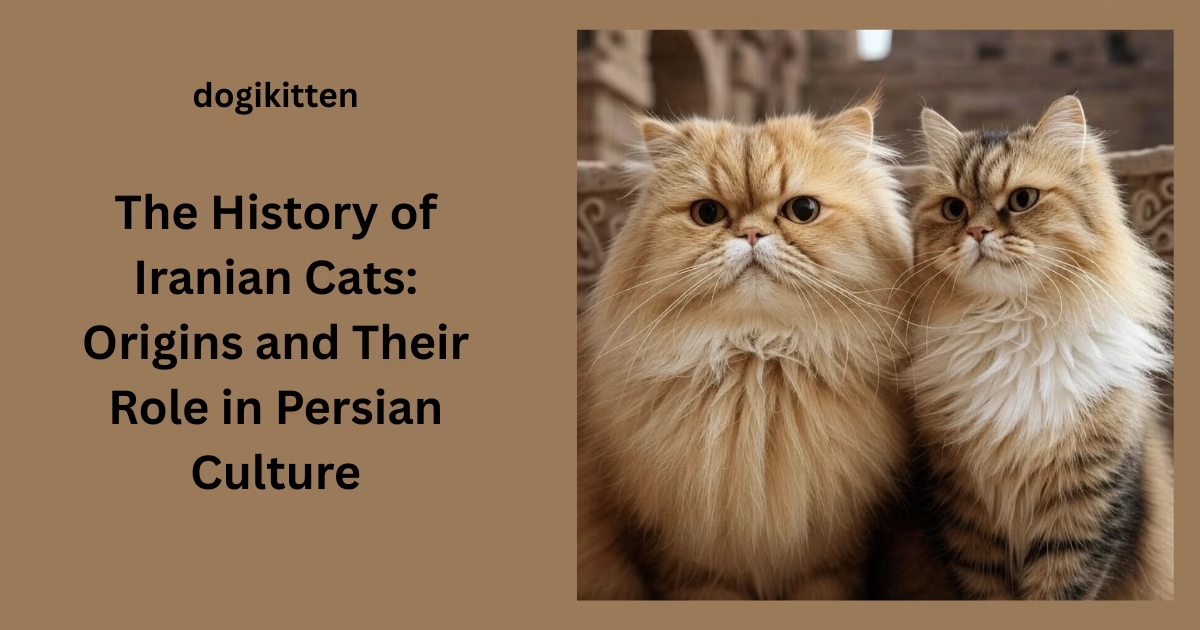
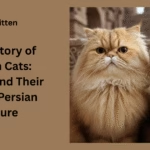
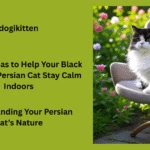



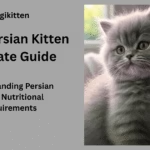




1 thought on “The History of Iranian Cats: Origins and Their Role in Persian Culture”